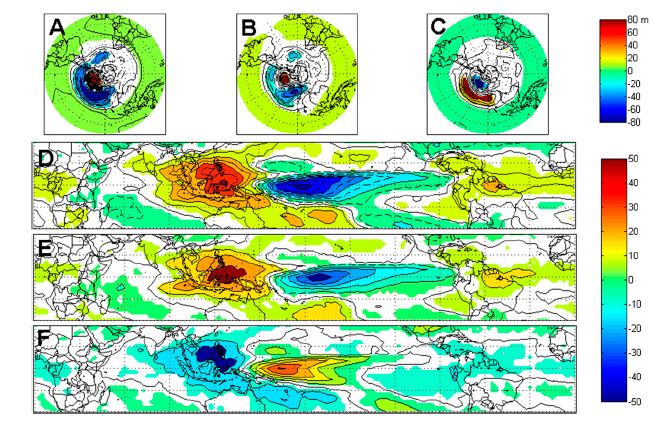#1. Radiation of planetary waves from tropical convection
Planetary Wave Trains

Figure 1. ECMWF monthly mean height anomalies (1995-2004) show the wave train that emanates from convection near Indonesia, propagates energy poleward in the UTLS (panels e,f), then upward into the austral stratosphere (c,d a,b). This amplifies from August to October as zonal winds weaken during SH spring. Ozone-rich air is found in the ridge over the South Pacific. (cf. Hitchman and Rogal, 2009a,b; Rogal et al., 2010).

Figure 2. ENSO modulates the distribution of clouds in the Indian Ocean - Pacific Ocean region, with the center of change near Indonesia. This modulates the distribution of height anomalies in the Southern Hemisphere. Top: Annually averaged 500 hPa geopotential height anomalies (m) for a) El Nino minus La Nina, b) El Nino minus neutral, and c) La Nina minus neutral, with regions of statistical significance exceeding the 95% confidence level represented in color. d), e), f) same except for NOAA OLR anomalies (W per m2). Solid (dashed) contours indicate positive (negative) values. Note that in the Ross Sea area geopotential heights are anomalously high during El Nino and low during La Nina (Welhouse et al., 2016).
Figure 3. Some authors have explored dividing differences in the source region for planetary waves from different parts of the tropics. This schematic illustration shows typical wave trains associated with the (a) Indian Ocean Dipole (IOD) and (b) ENSO for JJA and (c) for the IOD and ENSO together for SON. This description is for positive phases of the IOD and El Nino. Typically opposite patterns occur during negative IOD and La Nina. Shaded blue (red) areas indicate regions of increased (decreased) tropical convection. Blue (red) contours indicate anomalously low (high) upper-level heights. The dashed lines trace prominent wave trains: gray for the Eastern Indian Ocean wave train, green for the Western Indian Ocean wave train, and orange for the Equatorial African wave train. The PNA and PSA wave trains are not marked but visible in (b) and (c) (Cai et al., 2011).














